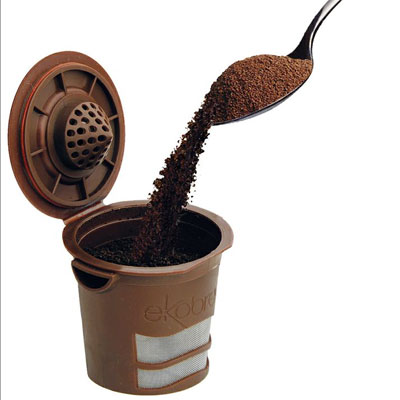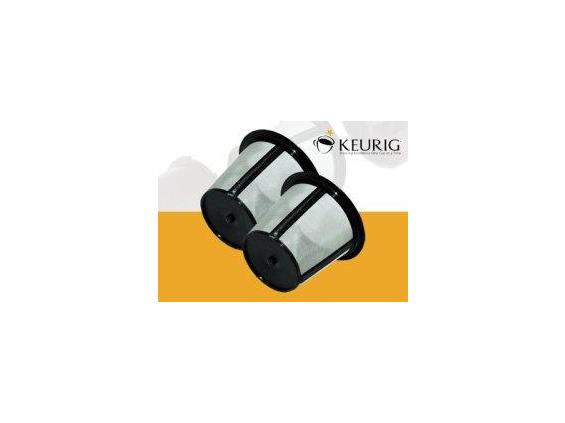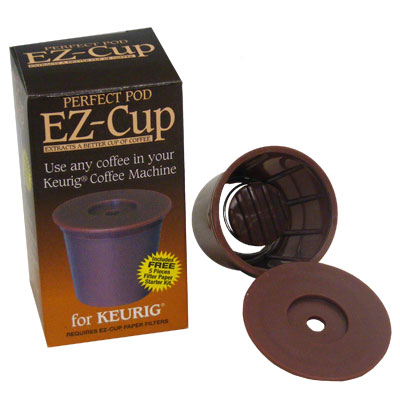The Keurig coffee maker can make good coffee. It can make it neatly and quickly. What it can’t do is make a good, cheap cup of coffee.
The problem is simple: to make it easy and quick, the K-Cup manufacturers have to do a lot of processing to get it ready for you before you buy. They have to grind, dose and seal each of those little cups. All that processing equals greater cost for you, the end user.
But what if you’re willing to take on that processing yourself? Buying your own coffee, grinding and packing it into a cup would certainly trim down the overall costs. Keurig has a solution of its own: The “My K-Cup” kit. But at 17.99 at Amazon it is not the cheapest nor simplest solution out there. This kit also requires you to pop out the cup holster for use, which is a bit more hassle.
But Keurig is not the only game in town when it comes to reusable cup solutions. There’s the Ekobrew reusable cup. It’s 10.99 at Amazon.
The Ekobrew jumps out ahead of the My K Cup on design and ease of use. Instead of several individual parts, the Ekobrew is one single piece, including a hinged top that swings completely clear of the basket for easy filling. There’s nothing to lose, and more importantly, nothing to remove from the coffee maker as the My K Cup requires. Once loaded, it acts just like a regular pre-packed cup.
It is easy to load as well. The My K Cup’s mesh basket is very lightweight on it’s own and needs a couple of stabilizing fingers to keep it from tipping while filling with coffee. The Ekobrew has a bit more heft and stayed in place for me. This isn’t a big deal, but I found that balancing the coffee bag, filter and spoon required one more hand than I came equipped with. The Ekobrew scored points for me here.
Once loaded, just snap the hinged top closed and drop it into your coffee machine. Unlike manufactured cups, there IS a specific orientation for the cup to sit … the writing on the cap must be toward you. This positioning allows the exit needle at the bottom of the holster to fit into a recess molded into the cup. Otherwise you’d punch a hole in the hard plastic bottom and probably ruin the holster. It would be hard to make such a mistake, as the cup won’t “feel” right as you set it down in your machine… it would wiggle and rattle and I found myself rotating the cup looking for the correct “fit,” which I found inside a half turn.
Just run the Keurig as you would normally do. Remember, there is a bit of exploration to be done here as you find the right amount of coffee and right serving size to best work for your tastes. As with the My K Cup, it is advisable to stay with a drip grind for the cup. Any finer and you risk clogging the mesh and making the brewing cycle too long.
Once done, I suggest rinsing out the cup pretty quickly, even while the cup is still warm from brewing. This makes for easy removal of the wet grounds simply with a running tap. Let the grounds dry and you’re in for some scraping and washing. Do it, it only takes a minute while the grounds are still wet.
How’s the coffee?
I made some tests with the same batch I used for the My K Cup tests, Peet’s Major Dickason’s blend decaf. I found it to be quite pleasing and robust, not too bitter or oily, which is something I worried about when using a non-paper filter system. The only downside is there’s a good bit of silt left over at the bottom of the cup, a sign that some smaller particles slipped by the mesh and wound up in my cup. This is not a big deal, ask anyone who uses a french press…. but be aware that you won’t want to see if this cup is good till the last drop. You’ll wind up with a small taste of coffee silt if you do.
Who wins???
For my money, the Ekobrew takes it between these two “roll your own” solutions. It preserves the Keurig’s simple use mandate, it is easier to load and pops out of the machine without an issue. It is also about 7 bucks cheaper at Amazon and can be found elsewhere on the web for less. Grab one and give it a try.
But what if you want to take the “green” thing even a bit further? I mean, the Ekobrew doesn’t really recycle the old plastic cups, it just replaces it. What about a system that really live up to the “save the mama” doctrine and puts those old cups back into service? We’ll look at the “K-Kap” system next time.










